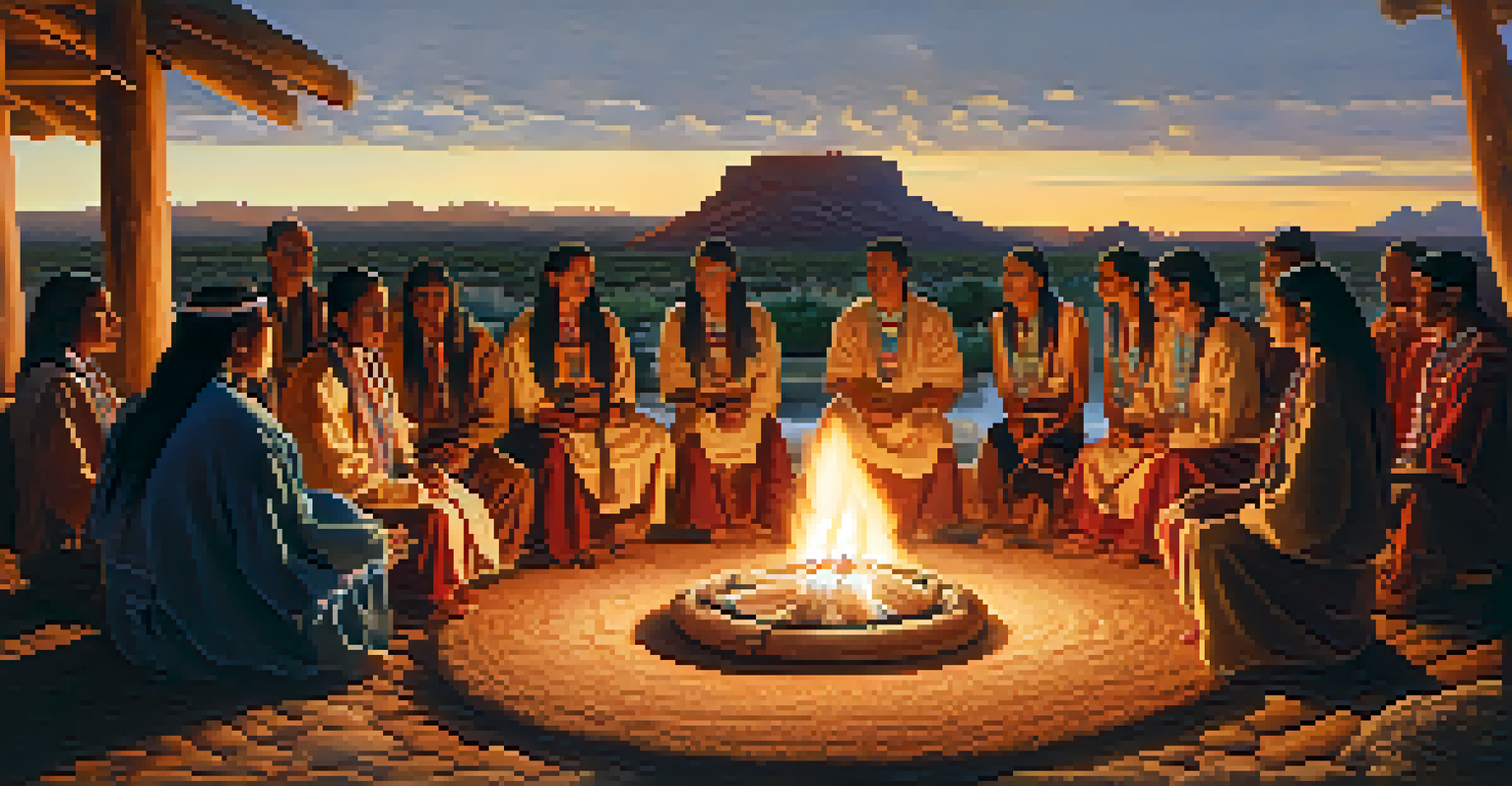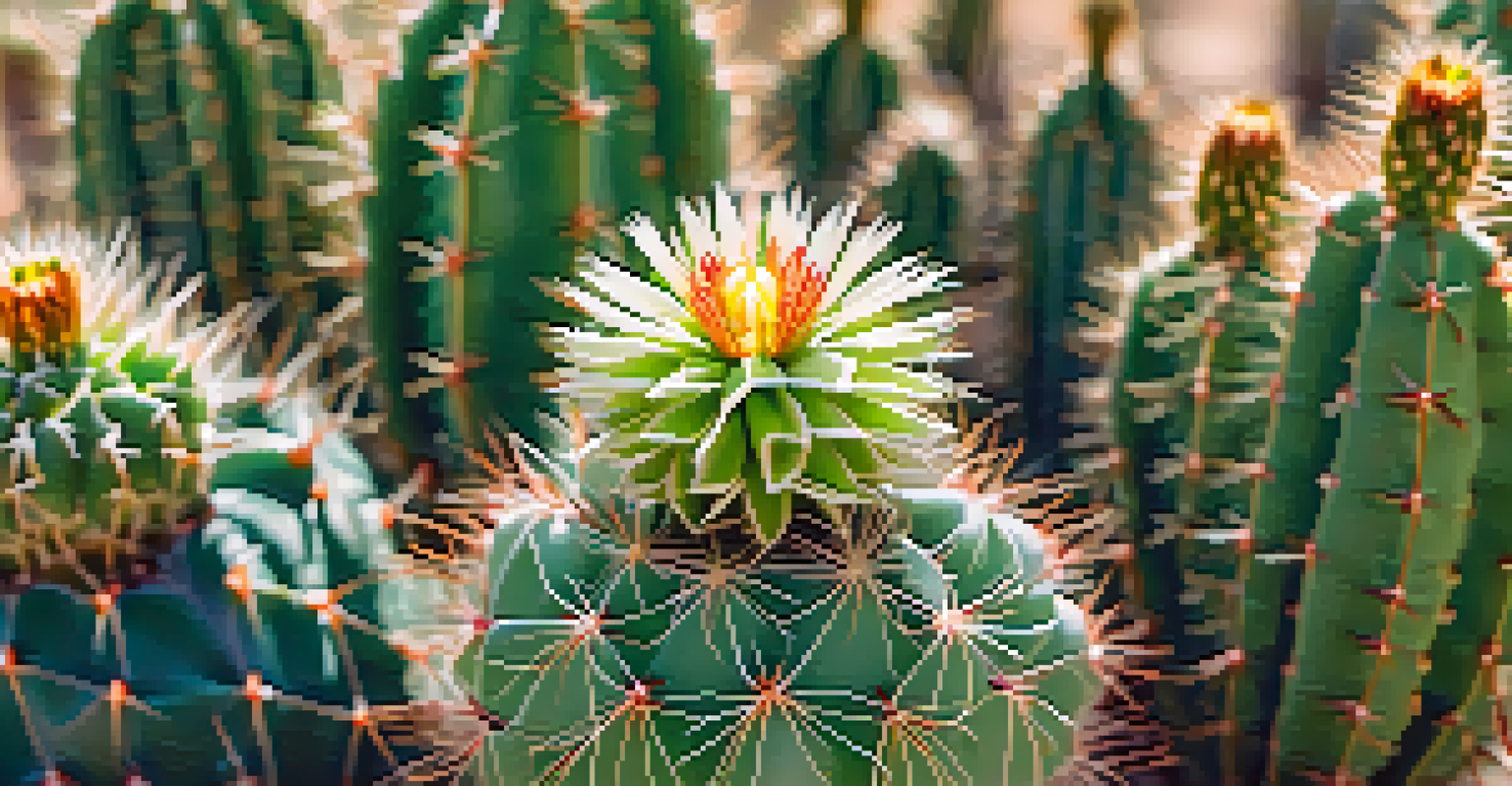Cultural Context: Peyote Use Among Native American Tribes

Understanding Peyote: A Brief Overview
Peyote, a small cactus native to the southwestern United States and Mexico, contains mescaline, a psychoactive compound. For many Native American tribes, peyote is more than just a plant; it is a sacred element of their spiritual and cultural practices. Its use dates back thousands of years, intertwining with the identity and traditions of these communities.
The use of peyote is a way to connect with the divine and to heal the spirit.
The significance of peyote extends beyond its psychoactive properties. It is often used in religious ceremonies, serving as a conduit for connecting with the divine and promoting healing. This cultural context highlights the importance of peyote as a tool for introspection and spiritual growth.
Additionally, peyote is viewed as a gift from the Earth, showcasing a deep respect for nature inherent in many Native American beliefs. This perspective fosters a sense of responsibility in its use, emphasizing the need for respect and understanding of its power.
Historical Significance of Peyote in Native American Tribes
The historical roots of peyote use among Native American tribes can be traced back to ancient rituals and healing practices. Tribes such as the Huichol and the Navajo have incorporated peyote into their ceremonies for centuries, viewing it as a bridge between the physical and spiritual worlds. This rich history showcases the plant's enduring role in cultural identity.

Peyote's prominence began to gain wider recognition in the late 19th century, coinciding with the formation of the Native American Church. This organization sought to integrate peyote use into Christian practices, allowing for a unique blend of traditional beliefs and new influences. This syncretism illustrates the adaptability of Native American spirituality.
Peyote's Cultural Significance
Peyote is a sacred plant in Native American traditions, used in spiritual ceremonies to foster connection with the divine and promote healing.
Over the years, the legal status of peyote has fluctuated, often reflecting broader societal attitudes toward indigenous practices. Despite challenges, many tribes continue to advocate for their rights to use peyote, emphasizing its cultural and spiritual significance.
Ceremonial Uses of Peyote in Native American Traditions
Peyote plays a central role in various ceremonies, such as the peyote meeting, where participants gather for prayer, singing, and sharing experiences. These gatherings often extend late into the night, fostering a sense of community and spiritual connection. The experience is seen as a profound journey of self-discovery and enlightenment.
Cultural preservation is not just about maintaining practices; it's about honoring the stories and histories that accompany them.
During these ceremonies, participants consume peyote to induce altered states of consciousness, allowing them to explore their inner thoughts and emotions. This process is often described as a form of healing, enabling individuals to confront personal challenges and find clarity. The communal aspect of these rituals further enhances their significance.
In many tribes, peyote ceremonies are led by a designated leader who guides participants through the experience. This role is crucial, as it ensures the ceremony is conducted with respect and adherence to traditional practices, highlighting the importance of guidance and mentorship in these spiritual journeys.
The Role of Peyote in Healing Practices
Beyond its ceremonial uses, peyote has been recognized for its potential therapeutic benefits. Many Native Americans view peyote as a means to address mental health issues, such as depression and anxiety. This perspective aligns with a growing interest in the therapeutic use of psychedelics in contemporary medicine.
In traditional healing practices, peyote is often used in conjunction with other rituals, such as prayer and singing. This holistic approach emphasizes the interconnectedness of body, mind, and spirit, which is fundamental to many Native American healing philosophies. Participants often report profound insights and emotional release during these sessions.
Historical Roots of Peyote Use
The use of peyote among tribes like the Huichol and Navajo has a rich history, often serving as a bridge between the physical and spiritual realms.
Recent studies have begun to explore the scientific basis for the healing properties of peyote, indicating that mescaline may foster neuroplasticity and emotional resilience. This growing body of evidence not only validates traditional practices but also opens doors for broader discussions about the role of psychedelics in mental health treatment.
Legal and Societal Challenges Surrounding Peyote Use
The legal status of peyote has been a contentious issue, often reflecting the broader societal dynamics surrounding indigenous rights. While peyote use is protected for religious purposes under the American Indian Religious Freedom Act, many tribes face ongoing challenges in asserting their rights. This legal landscape can create uncertainty for those who wish to partake in peyote ceremonies.
Societal perceptions of peyote have also evolved, often influenced by the stigma surrounding drug use. Misunderstandings about its purpose and significance can lead to misconceptions about Native American spirituality. Education and awareness are crucial in dispelling these myths and fostering respect for indigenous practices.
Advocacy efforts by Native American tribes and organizations continue to play a vital role in promoting awareness and protecting their rights to use peyote. As discussions around indigenous sovereignty gain traction, there is hope for a more supportive legal framework that honors the cultural significance of peyote.
Modern Adaptations and the Future of Peyote Use
As society evolves, so too does the use of peyote among Native American tribes. Some communities are finding innovative ways to integrate traditional practices with contemporary lifestyles, ensuring that these rituals remain relevant for future generations. This adaptability reflects the resilience of indigenous cultures in the face of change.
Modern adaptations may include the use of technology to facilitate virtual ceremonies or educational resources to engage younger members of the community. This blending of tradition and innovation helps to keep the cultural practices alive while honoring their historical roots. It serves as a bridge between the past and the future.
Challenges and Future of Peyote
Ongoing legal and societal challenges affect peyote use, but modern adaptations and advocacy efforts aim to preserve its cultural significance for future generations.
Looking ahead, the future of peyote use will likely be shaped by ongoing dialogue between indigenous communities, legal systems, and societal perceptions. As awareness grows about the importance of preserving cultural heritage, there is optimism that peyote will continue to hold a significant place in the spiritual lives of Native Americans.
The Importance of Cultural Preservation and Respect
Cultural preservation is crucial for maintaining the integrity of traditional practices surrounding peyote use. As external influences and modern lifestyles continue to encroach upon indigenous communities, the need to protect these sacred rituals becomes even more pressing. This preservation is not just about maintaining practices; it's about honoring the stories and histories that accompany them.
Respect for the cultural significance of peyote extends beyond the tribes themselves. It involves understanding the broader context of indigenous spirituality and recognizing the importance of these practices in promoting mental and emotional well-being. By fostering respect and understanding, we can help create a more inclusive environment for all.

Ultimately, the journey of peyote use among Native American tribes is a testament to resilience, adaptation, and the enduring power of culture. By engaging with and supporting these traditions, we contribute to a richer, more diverse understanding of spirituality and healing.